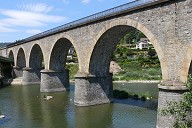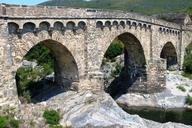Rehabilitation of the Balduin Bridge, Koblenz
The Balduin Bridge, dating from 1429, is the oldest bridge in the city of Koblenz. After a checkered history with numerous structural changes, a blast in World War II and reconstruction afterwards, the redesigned Balduinbrücke was finally completed in its current form in 1975.
The total length of the bridge train is 475 m. The arch bridge spans the Moselle with six vaults on the Altstädter side, three vaults on the Lützeler side and a prestressed concrete bridge in the middle section. In addition, there are three vaults as a bridge ramp up to Burgstraße. In addition, the so-called north ramp as a prestressed concrete structure connects the river bridge with Lützeler Straßen. The traffic significance of the listed Balduin Bridge is eminent for the city. Around 19,000 vehicles use the bridge every day, plus thousands of pedestrians and cyclists.
In the course of regular inspections of the structure, considerable damage was found on all parts of the structure. Due to the increased traffic volume, especially heavy traffic, but also due to environmental influences, damage caused by de-icing salt and normal material wear, the durability and traffic safety of the structure is permanently impaired. Therefore, comprehensive rehabilitation is necessary; the rehabilitation phase is expected to last until October 2014. The essential part of the construction work is the sealing against penetrating moisture, the strengthening of the vault areas and the renewal of the sidewalks and bike paths.
.The company Teupe & Söhne Gerüstbau GmbH, NL Rheinland, Dormagen, was awarded the contract for the scaffolding of the bridge piers and the construction and erection of a 2.50 m wide, barrier-free temporary bridge for public traffic (pedestrians and cyclists) over the entire length of the bridge span. The temporary bridge consists of 3 sections (Altstädter side, prestressed concrete bridge and Lützeler side) and is designed including bridge bearings. The temporary bridge was designed and calculated by the Teupe technical office in accordance with DIN Technical Report 101. Only three weeks were available for the technical processing, static calculation with execution drawings according to ZTV-Ing as well as the workshop drawings, so that the steel construction production had to take place in parallel to the technical processing at Teupe.
In the area of Altstädter Seite with a length of 246.00 m, the foundation of the temporary bridge was carried out by means of elaborate core drilling on the existing pier templates of the arch bridge. The max. span here is 26.80 m. The structure was made of steel girders for which a total of approx. 200 t of steel were used. The individual bridge elements of up to 27 m length and 20 t weight were prefabricated and delivered by heavy transport from the Teupe workshops. In order to keep to the extremely tight schedule, the bridge had to be fully closed on several nights between 10 pm and 5 am. Two Überbauteile were lifted in and assembled per closure break.
In the area of the prestressed concrete bridge, an object-related special suspended scaffold for public traffic was erected below the cantilever arm over a length of approx. 100.00m. In the area of the Lützel side with a length of 60.00 m, the bridge elements were assembled on concrete foundations with steel support towers. Steel with a total weight of approx. 100 t was used for this purpose. Due to the poor subsoil, the foundations could only be built at a distance of at least 5.00 m from the Moselle. This meant a special static and structural challenge, which was overcome by cantilever arms and steel girder substructures in the area of piers 8+9. The lifting of the bridge elements was also carried out at night. In this area, the bridge is designed as a handicapped accessible ramp with rest platforms due to the slope.
The execution of all work and the construction of the entire temporary bridge was realized in 24 h operation in several shifts within 20 working days.
References
Structure Types
Relevant Websites
- About this
data sheet - Product-ID
7002 - Published on:
08/10/2013 - Last updated on:
03/03/2023

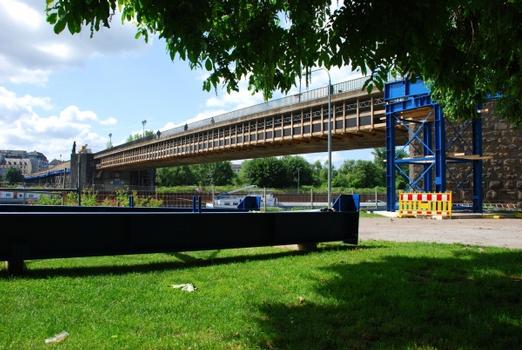
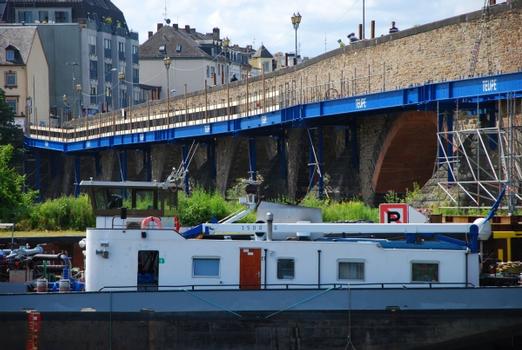
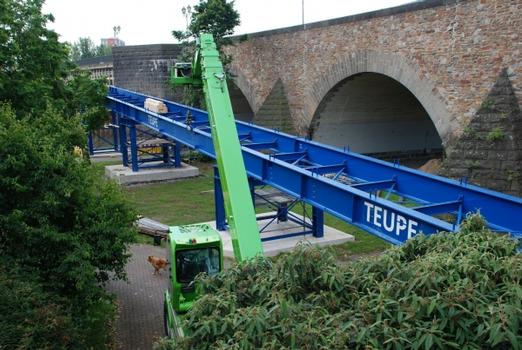
 Teupe & Söhne Gerüstbau GmbH
Teupe & Söhne Gerüstbau GmbH
